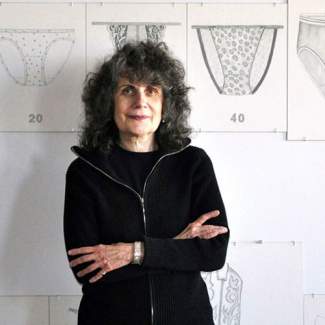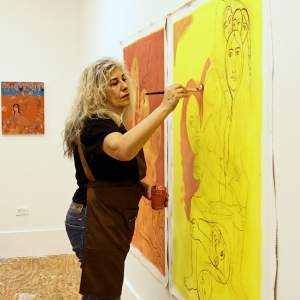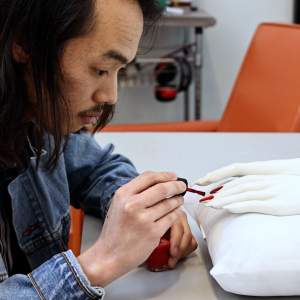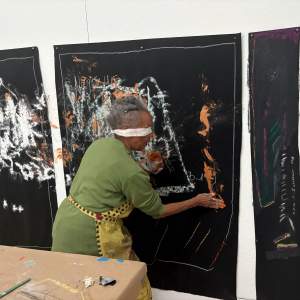Creating a Living Legacy: Mimi Smith
Mimi Smith
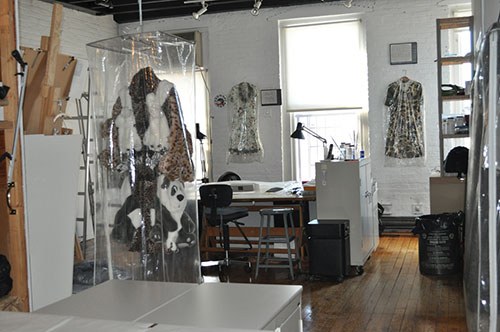
Can you share what has changed for you as a result of being a part of the CALL program?
My studio contains much of my 50 years of art. I have file cabinets, flat files, cabinets full of slides and photos, shelves with boxes, racks with hanging pieces and rolled up work all there. When people came to my studio they would often comment that it appeared neat and organized. But neat does not mean organized, everything was just haphazardly neatly placed where it fit, and it was only my fairly good memory that would allow me to remember details of past pieces and shows or find which works were where.
Some years ago I began to think, actually worry would be a better word, about what would happen to my work when I was no longer here to take care of it. I did not want my work to be a burden to my kids. I also did not want my work, much of which was installations and/or of unconventional materials, to not be the way it was meant to be. I started to attend panels, I kept jokingly saying, to learn how to be a dead artist. I noticed one of the first things they all said was archive your work, have a database. Knowledgeable about graphics programs, I had never used a database program and my few feeble attempts, to create lists with images went nowhere. But, while attending one such event, I met a man from the Joan Mitchell Foundation and that is how my CALL database happened.
Can you give us a sense of what needed to be accomplished when you started working with the CALL Program?
With lots of different kinds of work from different series and periods all together on the same shelves, in the same cabinets and flat files, some with supplies, etc., I did not know where to begin. I wanted to start chronologically, but nothing was in any real order. Then my assistant from JMF said, let’s just open a drawer and start, and that was what we did. Over 3 years later and with the help of my three wonderful JMF assistants: Allison Schooler, Catherine Czacki, and Denise Schatz, I now have a huge list of most of my works. Along with year and details, the list tells where in my studio each work is and/or its parts are. That makes it sound like it was simple and is now ordered and finished. Neither is true. It was not simple and there is not enough space to really make everything ordered the way I would like it. And, it will never be finished. Not only do I keep making more new pieces, but also old pieces keep appearing. But, I am very happy now that I devoted the time and energy to the task, and with the incredible help of JMF and their great assistants I was able to accomplish all that. It has been wonderful and I truly appreciate the opportunity I have had.
What has been the most rewarding aspect of this work? What has been most difficult?
Although the three years spent making the database took time away from making new artwork, which I found discouraging, it was helpful to all of my work because it brought to life certain things. I discovered how bad my old photos were. The installation shots were not too bad since I had photographers do those. However, slides of individual drawings, etc, were often so poor that my photoshop skills were useless. During our weekly visits my JMF assistants would help me to re-photograph these. Then I would spend a great part of the rest of the week fixing the photos. While many aspects seemed like a chore during the process, the results are amazing. To me the database makes it all more understandable and explains everything. It shows that individual objects stored in diversely different parts of my studio go together to create one work or one installation. And, I now have viewable images of most of my pieces. In addition, many of my works have audio. This is not at all finished, but when it is it will show which drawings and which installations belong to which audio, a worry minimizer for sure. I intend to keep working and making the database even clearer. Next I hope to get installation instructions that go with various pieces, and are in a file cabinet nowhere near the parts of the pieces that they belong to, in the database with the works they go with.
What do you recommend to artists who might be in the early stages of creating an inventorying system?
If I had one recommendation to give to beginning artists, it would be to take the best photos that you can of your work. This will show the work in its original state, when it was new. To my surprise, some works do not look physically the same as they did decades ago and the photos therefore are of slightly different works. The other recommendation is to start archiving and databasing as you make the work. My current JMF assistant tells me that she has already started. It is much easier to do it when the work is created than waiting and having to go through decades of art.

